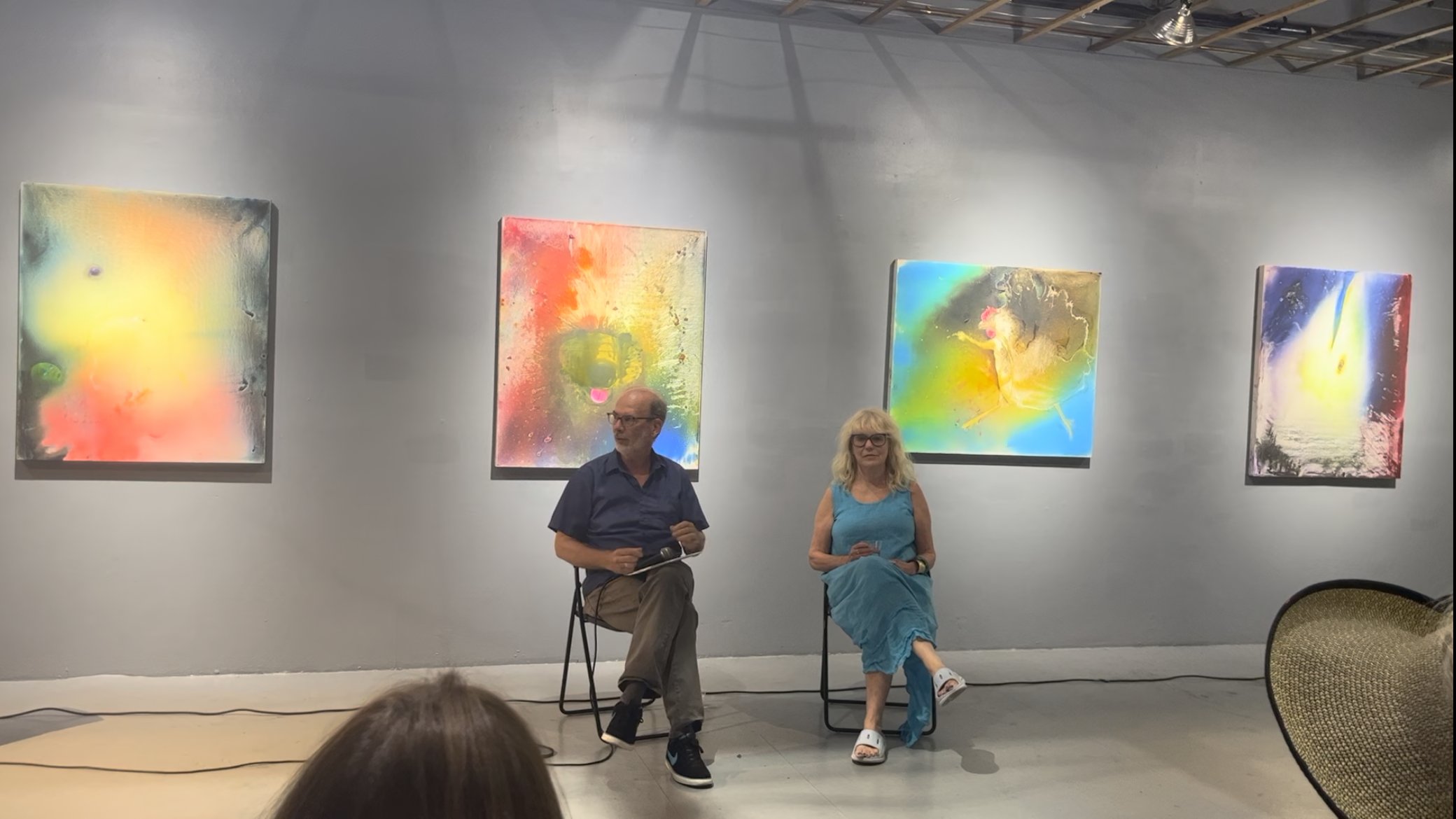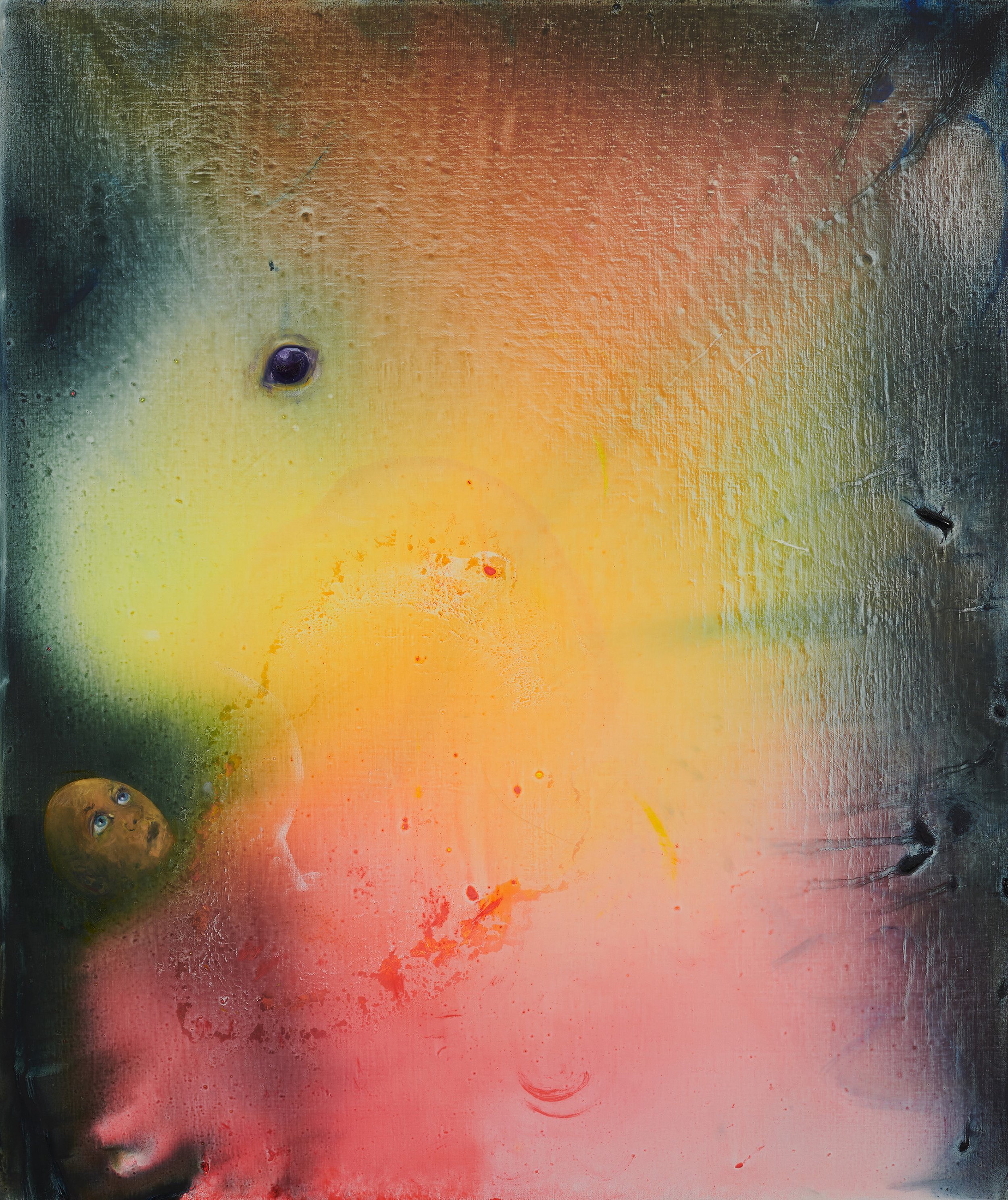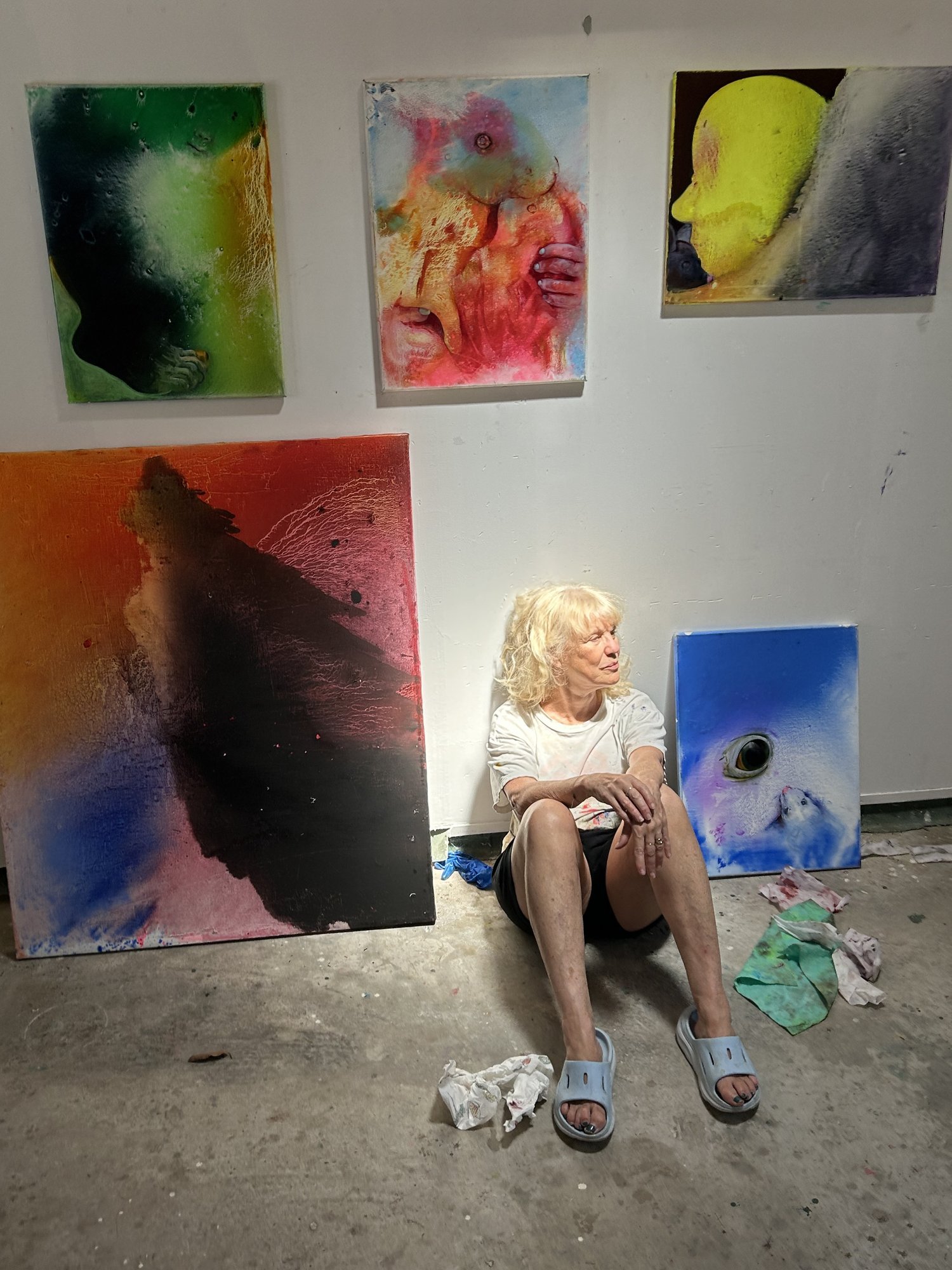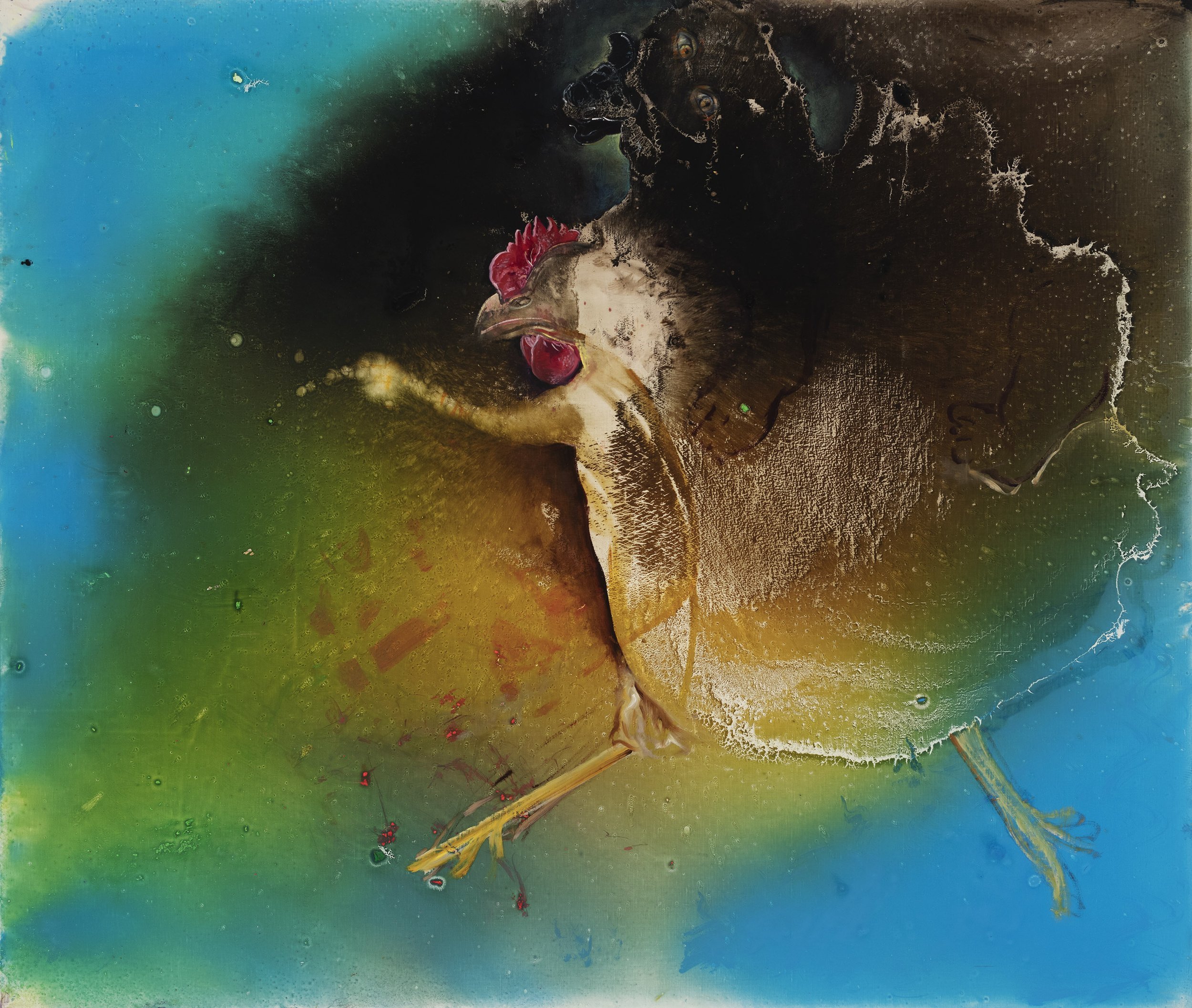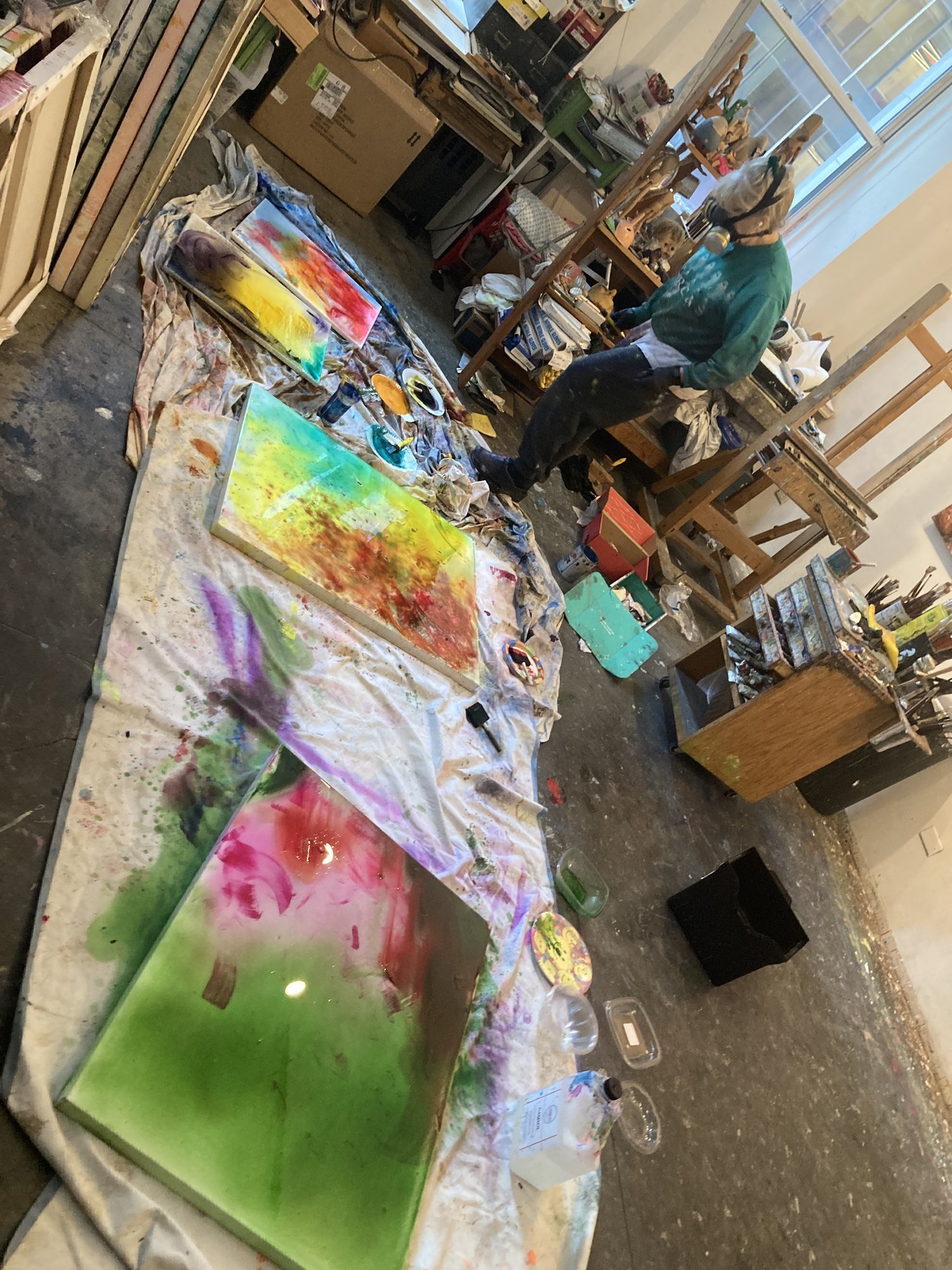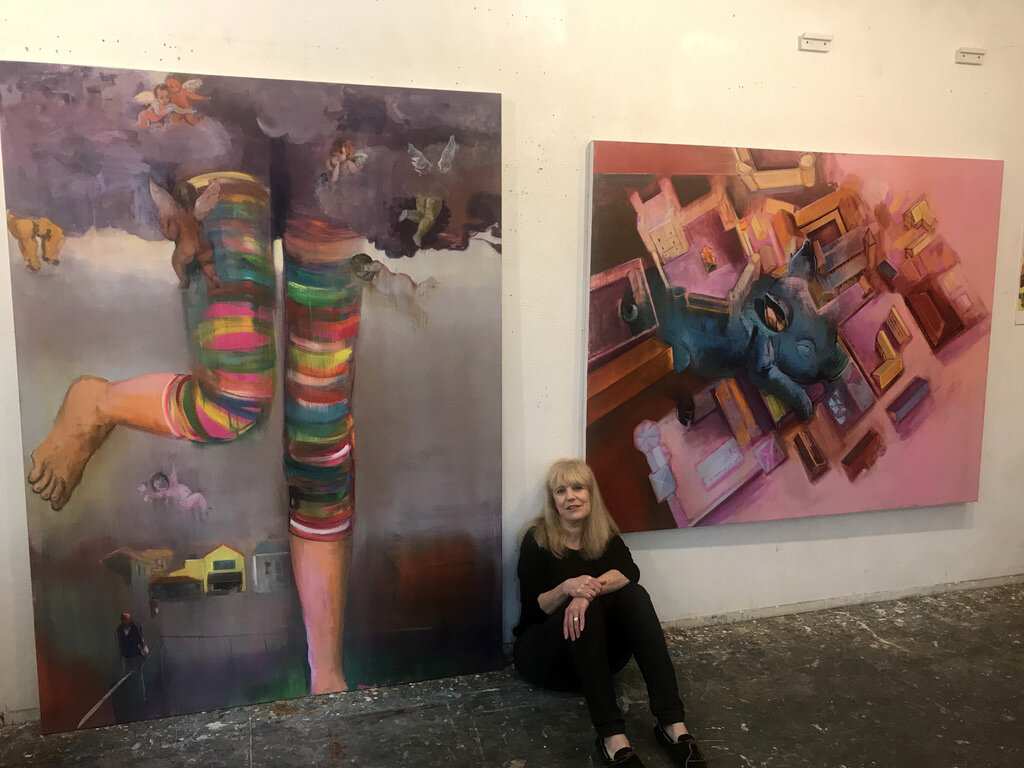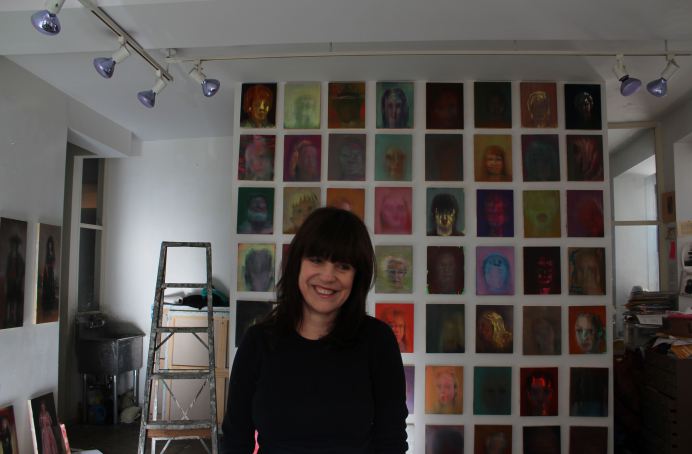WGXC 90.7-FM
The Passage: Barbara Friedman
Radio Interview
Sep 12, 2013
Hosted by Richard Roth.
Roth: This is Richard Roth with The Passage, our monthly show devoted to the creative life. … My guest today is an artist, Barbara Friedman, who has the show up at BCB Art, Warren Street, closing on Sunday with a closing reception to which one and all are invited … Barbara, welcome. How did you happen to end up showing at Hudson here at BCB art?
Friedman: I got an email from Bruce out of the blue a few years ago (he’d seen my paintings online, I guess), and was really pleased to hear from him. We’d gone to RISD together many years ago. We were undergraduates there but didn’t know each other well … He contacted me and said that he liked what I was doing, and did I want to send him some images; and I did; and that led to my first show there.
R: Were you doing a similar kind of work when you knew each other back, way back then?
F: Well no, I was a painter and I was doing, let’s see, as an undergraduate at RISD, I was doing pretty painterly paintings of swimming pools actually, that were a little pop- inflected; also, basic color studies. Bruce was in printmaking and doing pieces that were kind of wry and a little bit conceptually oriented and if I remember correctly somewhat text-based. I remember that they were also always really funny. I liked that. But we didn’t know each other well at all.
R: And so then you went on from RISD to UC Berkeley?
F: I did. I went to San Francisco to the Bay area pretty much directly from RISD and before I went to UC Berkeley, I spent a year painting and teaching full time. I was teaching at two different private schools. I taught art and French. I did then start an MFA program at UC Berkeley but I continued teaching while I was a student.
R: And then you came back and started teaching at Pace University?
F: Yes, after I finished grad school I wasn’t sure if I was going to stay in the Bay area or I was going to move back to New York. When I said “back to New York,” I’d grown up in New York and had left when I was fourteen and always vaguely assumed that I would return someday. I just didn’t know when. So, when I finished Berkeley I was on the fence about it. But I did go back and after a few months I was offered an adjunct course at Pace University. I took it and then a few years later that turned into a tenure track job which was great and let me remain in New York and paint.
R: So you’ve been there now for thirty years I think?
F: I have been there for thirty years, yes, exactly. It is kind of daunting but what can I say?
R: When did you start doing this particular body of work with these – I should say that the show at BCB now is based on copying paintings in museums. You have close to a dozen paintings, plus a number of drawings. When did you start doing this kind of work?
F: I guess about maybe two years ago now. The first time I actually worked on site in the museum was maybe three years ago. I’d always been very curious about … that strange trope of the copyist and the faithful renderer or the academic hack – they have different guises – the person who goes to a museum and sets up their easel and faithfully copies a masterwork. It’s such a time-honored tradition and one that I wasn’t at all exposed to as a student. I was an undergraduate in the 70s and it was really antithetical to the way I was taught.
R: At one time was that the standard practice? You went to the museum and copied?
F: I think it was, especially in Europe. You still see more copyists, I suppose, at the Louvre than at the Met. And certainly students at the academy worked from plaster casts. Not only was I not educated in that tradition, but it doesn’t go with my personality. I tend to make pretty quick, impulsive pieces. And I am far too self-indulgent and impatient to follow a careful technique or to consider waiting for laborious glazes to set, so it is surprising that I’m even interested in the whole idea. But for some reason I’ve always been curious about why people would do that and how they came to do it.
I also associated the practice somewhat with ladies or lady copyists so there is a little bit of a feminist curiosity there too, because it obviously is not a tremendously valued practice and it has the sting of the hobbyist to it … I am also interested in what it means to paint from observation if you paint representationally as opposed to painting from photographs or from your memory. Working from life (from observation) is a little old fashioned and academic and so I’m always excited when people do it in a way that makes it feel fresh.
For instance, right now, there is a fairly young artist named Josephine Halvorson who is painting from observation. She tends to travel to make her paintings and she will focus on a piece of wall, for example, that tends to go ignored. She does all of her paintings in one sitting. I think that’s emphatically part of her practice. And then somebody like Rackstraw Downes does the same thing, of course he does much more labor-intensive lengthy paintings. Though they both seem to far prefer depicting a place that wouldn’t be considered particularly picturesque.
So, there are the people who do that, and insist on their presence, and who feel that there’s something experiential in being there and looking. I wonder if you really feel that in their paintings. I’m not sure you do but Catherine Murphy has that approach too. I am fascinated by the fact that she has this painting of her husband lying on a garage floor. She made him get back in that uncomfortable pose over and over and over again instead of just photographing him. And I wonder, is that communicated in the painting – that craziness? I’m not sure. Personally, I sometimes paint from photographs, sometimes out of my head, I often manipulate images, and occasionally I make work from observation. In this case I really wanted to set up strict guidelines and adhere to them and see what happened.
R: So now if you are standing in front of a Goya or Rembrandt or whatever and you are copying it, the finished product is of course not a line for line copy. At some stage in the painting is it pretty much a representation of exactly what the painting looks like?
F: Usually they end up looking somewhat like the painting. Some of them are barely recognizable and the original source pretty much disappears, not entirely but mostly. But generally at the beginning, they do look something like, though not exactly like, the painting that I’m looking at. I see these paintings as portraits of the sitters in many ways as much as they are about the artist that painted them. And these are pretty much all paintings of people. There is one case in which I have three paintings made from a single painting. One of them is much closer to the original than the others; it’s a portrait of a Dutchman. I think it it’s a Jacob Backer, a minor Dutch master. That’s in the Brooklyn Museum. I don’t think it’s in the Brooklyn Museum any more, but it was when I painted it.
There is one painting I made from the Backer that is much more faithful to what it actually looks like, and then the one with the scratched-out orange face is the same painting; and that one with the collar, there I ended up being really interested in the figure-ground flipping that occured. Again I didn’t think that would be the point of the painting but it ended up being what I was interested in.
R: Now at some point was there a lot more paint on the surface?
F: Yes, there always is at some point a lot more paint on the surface.
R: And how much time do you spend on one?
F: That’s a good question, they have tended to happen faster and faster which is a little unsettling and I don’t want it necessarily to be the case. Usually, it’s anywhere from one to three sessions. And the sessions are pretty restricted because I can only be there when the museum lets me be there. The permit is maybe for a month, two or three days a week. Three hours a day or something and I am not necessarily there all three hours.
R: And when you are painting, do people come and look over your shoulder and comment and so on?
F: Absolutely, and that’s where the performance anxiety comes in, because I’m not interested in being the snobbish painter doing something that nobody appreciates –that the general museum-going populace doesn’t get. But I’m also not interested in just doing a copy because I’m really not a copyist, I mean that’s really not my project. However, I don’t want to be mocking that tradition particularly either. I’m sort of riffing on it but not in a scathing way.
So, since I started out by painting the painting, somewhat, people might be impressed and say “Wow, that’s cool.” And they seem to like the fact that I have done it quickly. And that’s just the way I paint, so maybe they will see me setting up and then a half an hour later, there will be something that superficially looks like the painting and they like that. And then five minutes after that, I’ll eradicate it completely and I will hear gasps and then that feels weird. And then after that God knows where the painting goes and any audience there is probably not interested in the painting once I started getting interested.
In addition to having that feeling, I’m anxious because I have no idea where the painting is going either. I really lose my audience and I am also conscious of the fact that now everybody around me thinks that I can’t paint. But what can I say? That is the trajectory.
R: So the painting is actually finished on-site?
F: Yes. I have these rules that it's got to be finished on-site. It doesn’t have to be finished in a single setting. I can let it dry; take it home. Some museums will let me leave it there. The Met is incredibly strict, but they will let me leave the painting there. And then return to it, bring it back on-site. But I won’t work on it in my studio later. I have to work on it in front of the actual piece I’m looking at.
R: How many paintings in this series have you done, do you suppose?
F: I am not sure. Let’s see how many paintings are here? There are fifteen or something like that. So, maybe I have done forty or so. I have also done tons of other head paintings, some of which are historically informed; but I didn’t do them in the museums, so I don’t count them. I do see the divide between the work that I really did on-site and other sort of portraits that were not done on-site. I also do drawings on-site.
R: Yes. Talk about the drawings a little bit too.
F: Well, on days that I did not have a permit and it is hard to get a permit, I drew in museums. Again, this is last year or so. I tried different mediums, I used pencil or watercolor. You are not really allowed to use watercolor at the Met but I also used charcoal and I found that my drawings were pedestrian and boring, just these straightforward drawings based on whatever I was looking at and it didn’t really interest me. But I did persist in doing them. I figured I would let myself paint from the drawings that I did on-site.
One day, I was using a sketchpad that a friend had given me, a pastel sketchpad that had glassine inserts in between the pages. And it was completely coincidental that I used that sketchpad, just happened to grab it when I left. So at the museum, I did whatever drawing I was doing, closed the sketchpad, threw it in my backpack and came home. When I opened it, I realized that the imprint of the vine charcoal drawing … had transferred to the glassine, essentially becoming a monoprint. It was infinitely more interesting than the original drawing. So after that, I would deliberately do drawings in this sketchbook. Then I ordered another sketchbook like it and I would just do a drawing and try not to think about the fact that I would want to see how it would look on the glassine. I would make the drawing as I had done before and close the sketchbook, put it in my backpack and then open it when I came home. Again I would try to keep these rules and then whatever had transferred would be the drawing. And sometimes much more transferred than at other times. Occasionally it was full of finger prints or various disturbances, which could or could not be interesting but whatever it was, it was. And I did really like that mediation. So, those are the drawings.
R: And can you go and draw at the museum without a permit?
F: Absolutely! Anybody can draw at the museum. It’s a question of wet or dry media. People are really worried that, understandably, work can get ruined and I was surprised because somebody posted a photograph that had been taken of me painting at the Brooklyn Museum. They posted it on Facebook. I had not realized the photograph was being taken, and I didn’t know that it was going to be on Facebook; and it elicited a lot of comments because I was holding a big broad brush, and I was painting from a Rembrandt, and it looked like I was a lot closer to the Rembrandt than I was. Somehow the photograph flattened the space. It was interesting how many people on Facebook who didn’t know me remarked on that proximity, and on how terrifying it was – what could happen. The Rembrandt was covered by glass, but still it was interesting.
This made me think about my relationship to vandalism, or the subversive aspects of my activity. And at the time there was a thing going on where there was this art heist by some Rumanians – what are the details? – one guy had given some stolen art to his mother, who’d hidden the paintings in their village. I was intrigued by that story. Then there was also something about a woman painting green stripes on different Old Masterworks. I haven’t really located myself within this framework of art stories. But there was something about them that felt relevant. Like what is my relationship to being so physically close to these pieces?
R: When you are teaching, do you have a particular technique? What do you teach?
F: I’m a pretty open-minded teacher. I don’t know how technique-based my class is. I do teach Painting I and Painting II. I have taught painting for years, but I think I encourage even beginning painters to find their own voice. And I try to give them the vocabulary for that. We start with the basics but I let them extend themselves fairly rapidly.
R: How many students do you have in a class?
F: Well, Pace theoretically sets the cap at seventeen. But we tend to allow more people to add the course. So, it could be up to twenty.
R: And do you sometimes follow students through more than one year?
F: Oh, absolutely, yes it is always gratifying to have returning students. I guess it is part of the joy of the teaching. To see them evolve.
R: And that’s something you do enjoy - teaching?
F: Oh I do, I do. I was going to say that I also love being in my studio, though right now I guess I am using the museum as my studio.
R: Now what about your earlier paintings like school buses and hammocks and things like that? Those are also painted from life?
F: No, those were mixtures. I did do some sketches on the spot, but I also took a lot of photographs. The way in which I paint makes the image disappear and reappear and morph and mutate. So, at a certain point I’m just responding to the painting. Though often I will start with an image which disappears and then eventually reappears usually in a different form, and that’s true for these paintings too. I don’t think the process is very different here. It’s just the imagery that is different, the source material.
One thing that I just touched on earlier was the idea that these were really portraits of long-deceased models. I find something compelling about painting these subjects who are no longer alive but feel very alive. I’m not only identifying with the artists who painted them, but also with their subjects and I hope that relationship is being communicated in the works.
R: Are there painters whose subjects you find an easier connection with?
F: That’s a good question. I guess another way of putting that would be: How do I choose which paintings I make a painting of? And I leave that completely open. I tend or I have tended to work with a sort of Western canon mostly, though that could shift, but I think I just wander through certain rooms at the Met or the Brooklyn Museum. I actually loved working in the Hispanic Society as well. And I let whatever speaks to me, speak to me.
R: When you go to paint though, have you already chosen where you are going to paint or what painting you are going to work from?
F: That’s a good question because at the Met and the Brooklyn Museum you need to identify the painting beforehand that you are going to work from. So, I do choose it before.
R: You sort of location-scout or something?
F: I totally location-scout. Totally. And then you have to apply to paint that painting and they have to make sure the room the painting is in is not too crowded and you won’t be obstructing the viewpoint of too many visitors.
Which brings to mind something else that’s interesting about this process. At the Met, for instance, the painting that you make gets stamped with a stamp that says “This is a copy” so, I find that amusing. The seal of approval uses the language that is normally an artist’s greatest term of abuse.
R: Where do they put the stamp?
F: On the back of the painting, or rather “the copy”. So, that in and of itself could make an interesting piece. In every museum, you are not allowed to make a painting from a painting that’s the same size as the original. Which also ensures that it couldn’t be mistaken for the original.
R: I’ve seen in European museums I think, people would make the painting smaller than the canvas. I mean there’s sort of a blank frame around them?
F: Oh that’s interesting. I guess any marker, any signifier that alerts the audience that this isn’t the original. Similar to Magritte’s painting “Ceci n'est pas une pipe”, you know.
Of course I’m only really supposed to paint the one painting but since I paint quickly, what I did at the Met, the last time I was at Met, I was only allowed to paint this one Goya, this red headed Goya, here. But I did many paintings of her. None of them looked anything like each other but that was my way around only being allowed to paint from that one painting.
R: Can you take more than one canvas at a time?
F: I don’t think most people do this, but they did let me store a few small panels in their storage room. So, I had a few on-going works.
R: Now you knew pretty early on you were going to be an artist, right?
F: Not really. I think I always loved drawing and painting and I came to it pretty naturally. I was scared to say “I’m going to be an artist.” It seemed so full of hubris and so loaded with such big expectations that I didn’t dare to say such a thing till I was around twenty. But as a kid I acted the part of the class artist, meaning that I was the one who drew, and I was the one the other kids would ask to draw something.
I actually thought I would be a writer because I read a lot and I was more identified in a way with just reading constantly. I made the mistaken assumption that if you read constantly, you would write. That I realized later, really I like to read more than I liked to write. But I did in fact really like to draw and paint.
R: And then you decided by the time you were a teenager to go to art school anyway?
F: Well I didn’t start out going to art school, I went to a small liberal arts college in Wisconsin first and thought I might major in English, and then in fact ended up graduating early, majoring in Art, because I had enough electives to do so. But I didn’t feel in any way ready to consider graduate school. I felt I was just beginning. So, I decided to transfer as an undergraduate to RISD.
I was two years older than the rest of my classmates when I arrived at RISD because I already had a B.A. and after I got to RISD, I started following a conventional path towards being an artist and started to self-identify as an artist. But even then, it seemed so presumptuous.
I mean, it’s a presumptuous thing to assume. I guess at a certain point when I was living in San Francisco I realized, yeah this is what I do. It felt sort of inevitable. I think when I started painting, just sort of painting, I did fall in love with paint itself. So, I started to look at a lot of artists from whatever period who also really used paint with hunger and excitement. So, whether it was Elizabeth Murray, Philip Guston, Goya or de Kooning or, I don’t know, Alice Neel. I looked at them all.
R: Do you paint a lot, I mean do you paint everyday?
F: I try to, and my youngest daughter just left for college and so I am going to try to be even more disciplined about really getting into the studio or into the museum everyday. But I do teach full time, it is a juggling act, and so summers are particularly sacred.
R: You work in a city all the time or do you have a country place somewhere?
F: I work in the city. The city has my only real studio and I live in the same space as I have a studio. But my husband is Greek American, his father is from this tiny village off the coast of Turkey and he inherited a little house in that village and we do try to go there in the summer, if possible, for a few weeks and so that’s another place I paint.
R: You do different types of work there?
F: Well, at one point, it directly informed my work. I tend to work in series and narratively my work often tends to be dramas of displacement. It was very clear that most people in that little village had moved to Cleveland, Ohio, as my husband’s family had. And so for a while there I was making works that involved the idea of everybody from a certain place, in this case, that particular village, moving somewhere else; and when they were in the village, or when they were in Ohio, seeing the village. Always inhabiting both places at the same time, so I would conflate elements of both in one piece. And when I was in Lekka, the village, I would paint over Cleveland maps. That’s one time when I actually did work from observation, I would just paint straightforward views of the village from observation over maps of Cleveland or over Cleveland guidebooks, thus containing both places on one page so to speak.
R: You have any particular plans, or are you continuing this work for now?
F: I feel very involved in this work. I’m not sure what it will become but for the moment I want to keep haunting these museums and I can imagine making paintings in front of the paintings that look absolutely nothing like the paintings I’m working from. I could imagine looking at a portrait and having the painting I make become a landscape. Many of them already become total abstractions or practically total abstractions but again they have to surprise me. I don’t like working from too much of a preconceived plan. But yeah, I feel like I’ve only scratched the surfaces though here.
R: Have you shown this work in places other than BCB?
F: Yes, I was in a show in Bushwick, Brooklyn at Studio 10, a four or five person show of artists who reference art history in various ways, including a video artist who had a video portrait of de Kooning. And I also showed some of them at Valentine Gallery in Ridgewood. And I am going to have some work at Storefront Gallery, run by Debbie Brown, also in Bushwick; that show opens in December. So that’s basically some of the different venues that I’ve shown these work in. But as I said, I have only been doing them about two years.
R: Do you have any particular feeling towards Hudson River School painters?
F: Yes, actually. The series I did before this one that I showed at Bruce’s - I guess about four years ago - was overtly influenced by Hudson River painters. Maybe that’s one of the reasons I still love the train ride from New York to Hudson. I called that series “Overlook Paintings” and that’s because the word overlook is an auto-antonym, a word that means the opposite of itself. “Overlook” suggests a negligent way of seeing, to overlook something, and of course it also means an all-inclusive look where you see everything.
My work is really about trying to figure out where I am and about trying to re-negotiate my bearings. I always feel like I’m not really seeing whatever it is I am seeing. It is all very Proustian in a way.
Those Overlook Paintings were really about seeing and not seeing and they all tended to be landscapes and often landscapes that felt like they were bit of a takeoff on the Hudson River School. Because there would be these suggestions of majestic places, projectiles, overlooks with tiny figures, looking over some vast terrain, I mean it was all very greatly abstracted. Hudson River School meets color field painting. And I actually did one painting based on an actual Hudson River painting. It was “Kindred Spirits” so, yes the landscape and the river moves me, pretty deeply.
R: You grew up as a city girl?
F: I grew up in New York City but I left at fourteen. My parents were a lot older and my father retired when I was fourteen. My mother was Swiss and wanted to return to Europe. No, rather she felt that if she didn’t live in New York City, she didn’t want to be in the United States. So, we moved to France when I was fourteen and I didn’t come back to the States until college. I had this fantasy about returning, because it was during the height of hippie-ness. I felt like I was really missing out.
R: And meanwhile you were speaking French as your daily language I guess?
F: I was, yes. Though I went to British/American schools, I didn’t go to French schools but I did speak French. I spoke French as a kid.
F: Actually after 9/11, my work started emptying out, it had gotten increasingly narrative and then got more and more pared down. It’s interesting because in 1915, Paul Klee said that as people, artists, get scared, their work gets more abstract and I certainly found this to be true for myself.
And that was the time when I would do these pared down landscape-y pieces of a hammock or abandoned chair or school bus and the narratives were implied but merely suggested, certainly not really articulated.
The first time that really happened, I was doing a painting of a girl in a bikini lying in the snow under a hammock and I was thinking of this movie by Agnès Varda named Vagabond, in which a homeless girl is found buried in the snow. But I ended up really disliking the figure, because it seemed really literal, and I painted her out. I had put a pink underpainting down before I started the painting and the pink came through and made the snow rosy. There were shards of pink that kind of formed the hammock and that was the first time that I really left the underpainting or left little pieces of the underpainting and allowed them to determine the figure and I started doing that regularly after that. And I would just take more and more out, that became my process in a way.
I mean my process in all of the work is the same pretty much, where I put down a hot color and sometimes parts of it become the positive space, I scratch into the underpainting or I let parts of it show through.
R: So for example, this painting where there is hot pink, that’s actually…
F: That’s underpainting.
R: That’s underpainting, I see.
F: The green is underpainting next to it.
R: I see. Because we get the impression that it was put on afterwards.
F: Oh, not at all. You know, when I painted that Rembrandt with the green for instance, it looked very different, then I took it all out and I scraped into it, pieces came up, you know, all of that. But I never really know what I’ll end up doing. Some of them have very little underpainting that shows through like that one. I mean it’s just a little bit.
R: How are you removing the painting? Scraping it off or wiping it off?
F: Almost always scraping. But I have different tools, I have one tool like this, it is just a scraper and then I also have tools with a rubber point.
R: And when you do that scratching, you are consciously drawing really, right?
F: Yes, some of them are much more about drawing than others, I mean in terms of the “Pink Dress”, you can see that I have changed the tools for the arms there, that is just a line drawing with the scratching into it… But again, I try not to do the same kind of things each time. What I like about the yellow one that you brought up, is that it’s not typical and that it is not scratched into. What happened was that I really didn’t like the painting and I had a little turp with me so I used it to wipe everything away. Not because I wanted to see what would happen, but because I just wanted to get rid of it. However, surprising things did in fact happen. Some yellow came up unexpectedly and remained in certain places where the paint stuck. I like how, at that point, I no longer made any decisions about what it might look like and instead accepted what occurred. I do find that more interesting… so process is really important for me.
R: Is there anything you would like for the public to know?
F: I don’t know. I can’t think of anything else. I enjoyed talking to you though.
R: Then I will just say thank you very much for joining me today, Barbara.
F: Thank you Richard, it’s been really pleasant.

